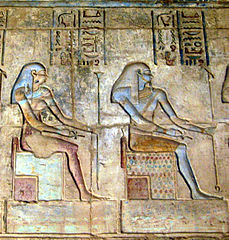
![]()
Mountain (djew)
The hieroglyphic sign for “mountain” depicted to peaks with a valley running between them. This image approximated the hills that rose up on either side of the Nile valley.
Although the djew hieroglyph did portray the mountain ranges the Egyptians saw in their everyday lives, it also was a visualization of their cosmic beliefs. Symbolically, the “mountain” was an image of the universal mountain whose two peaks were imagined to hold up the sky. The eastern peak was called Bakhu, to the west was Manu. The ends of this great mountain were guarded by two lions who were called Aker. Aker was a protector of the the sun as it rose and set each day. Continue reading
 Shen
Shen Heh and Hauhet, Deities of Infinity and Eternity
Heh and Hauhet, Deities of Infinity and Eternity




 Orgy scenes, such as the one depicted in Roses of Heliogabalus by Alma Tadema, did not exist, according to Dr Alastair Blanshard.
Orgy scenes, such as the one depicted in Roses of Heliogabalus by Alma Tadema, did not exist, according to Dr Alastair Blanshard. Two ivory Djed pillars found in a
Two ivory Djed pillars found in a

 Adinkra Index
Adinkra Index











Recent Comments